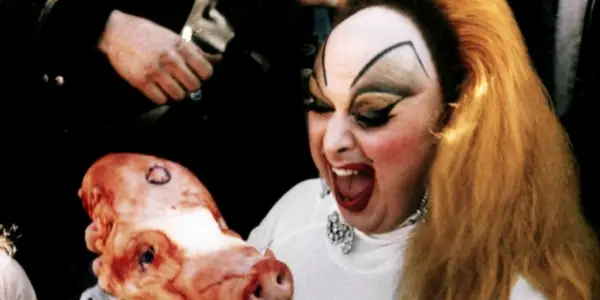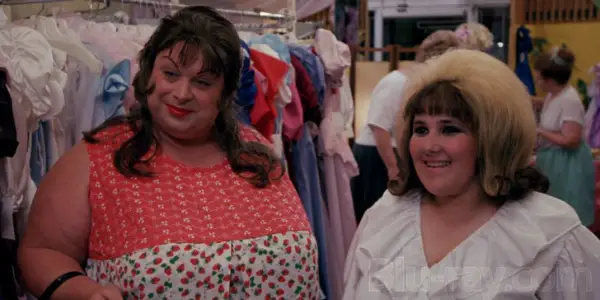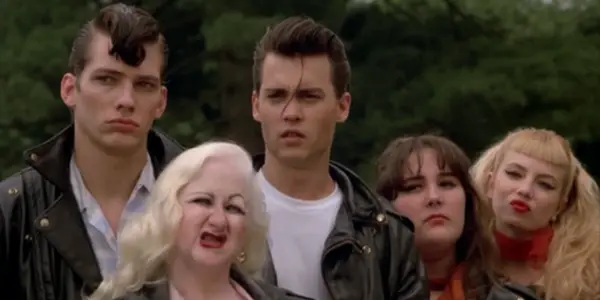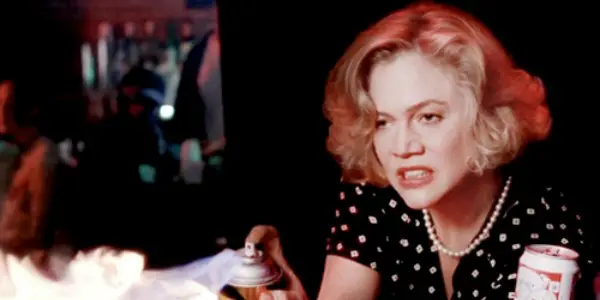The Beginner’s Guide: John Waters, Director

Lauren is 20 years old and is a Multimedia Journalism…
Rarely is a filmmaker as entrenched in infamy as John Waters. Born in Baltimore, Maryland in 1946, the king of counterculture became known in the 1970s for his creative collaborations with the equally infamous Divine and his gang of Dreamlanders. He began work as a director with a series of experimental short films including Hag In A Black Leather Jacket (1964) and the Andy Warhol-inspired Roman Candles (1966).
The eternally controversial director tends to focus on writing his work, with directing coming as a by-product. Waters has been known to denounce improvisation, citing writing as paramount in making a good film and has said: “I believe if you come out of a movie and the first thing you say is ‘the cinematography was beautiful’, it’s a bad movie.” His work, particularly in early days, has been described as an “exercise in poor taste”, with his lack of technical polish and penchant for exploring so-called low culture becoming a stylistic flourish in itself.
Mondo Trasho (1969)

Waters’ first full length feature, Mondo Trasho, was made on a budget of $2,000, which was borrowed from his father. It stands as an indicator of what was to come, combining a surrealistic storyline with a rock ‘n’ roll soundtrack and a shooting style lacking any form of technical know-how.
The basic plot follows Divine after she hits a girl with her car, engaging in various antics and being visited by the Virgin Mary. The film has very little dialogue, with the few lines – including the most famous: “Oh Mary, teach me to be Divine!” – holding greater impact for this reason. Waters instead made use of his record collection, with artists such as Chuck Berry and Little Richard providing the backdrop for the characters’ antics.
Waters noted in a 2008 interview that he never paid the licensing fees for using the music, and it is for this reason that Mondo Trasho has remained unreleased. It is available to view on YouTube, and the director has said that in hindsight he believes the plot would have been better suited to a short film. The use of rock ‘n’ roll helps enhance the surrealistic vibe of the film, whilst the lack of camera technique is a homage to mondo documentaries, also known as exploitation documentary/shockumentary, a sub-genre which celebrated taboo subjects.
Waters has never shied away from taboo, and Mondo Trasho opens with chickens being beheaded. Lacking the polish of his later work, though, it is clear the director is learning on the job. Whilst not for the easily offended, the film is essential viewing for showing where Waters began in terms of his feature film work, as well as for seeing an early example of an outrageous Divine performance.
The lack of dialogue means that the film is missing much of the wry insight and satire of Waters’ later work, highlighting how important his work as a writer is in his career as a filmmaker, but Mondo Trasho is still an intriguing look into the mind of one of the most notoriously twisted filmmakers in America.
Pink Flamingos (1972)

Whilst it was not until later in his career that Waters’ work began to be commercially viable, it was Pink Flamingos that cemented his status as an infamous, countercultural and unpredictable filmmaker who fully embraced anything taboo. The film once again stars Waters muse Divine, who plays Babs Johnson. Babs and her family embark on a journey to secure her title as the filthiest person alive after the Marbles challenge her position.
Talk about Pink Flamingos tends to be dominated by that scene, which saw Divine snatch back the crown of filthiest person alive by consuming dog feces before grinning at the camera. In terms of shock tactics, it is without a doubt effective, and the film has endured in infamy on this scene alone, cementing its status as one of the most notorious ever made.
Waters draws a suitably over-the-top performance from his lead actress, adding a layer of pantomime to proceedings, whilst his camera work strikes reminiscent of a home video with extensive use of zooming in and other seemingly amateur techniques. He also edited it, employing a very rough style which lends itself to the general ‘homemade’ feel of the entire film.
Many Waters trademarks are clear throughout Pink Flamingos, including a homemade looking technicolour. Bright colours, particularly Babs’ pink and green trailer, dominate the screen and, along with the rock ‘n’ roll soundtrack, inspire an idea of 1950s kitsch that perfectly juxtaposes the filthy actions of the characters.
Whilst easy to denounce, for anyone willing to attempt to delve deeper than the visceral repulsion the film will no doubt illicit, Pink Flamingos raises some interesting themes regarding the way we view criminals as celebrities, and the role society plays in encouraging outrageous behaviour. Babs, having been given her title by a tabloid, seeks to keep it by engaging in increasingly outlandish acts in what seems like a very fitting commentary on reality TV of the present, in spite of the film being 0ver 40 years old.
Pink Flamingos is one of the most important films in Waters’ filmography, where his critique of pop culture that he explored later in his career meets the gross-out elements of his earlier work, creating a nauseating cult favourite.
Hairspray (1988)

By the 1980s, Waters was well known for his highly controversial, X-rated work. It therefore came as a surprise to everyone when he made Hairspray, a PG-rated film which appealed to a much broader mainstream audience as it took viewers back to the early 1960s, the last age of innocence. The film stars Ricki Lake as Tracy Turnblad, an overweight teenager with a passion for dance who is desperate to appear on The Corny Collins Show. The film became a cult hit and spawned a hugely successful Broadway musical. The musical then inspired another cinematic adaption in 2007, but the less said about John Travolta in drag, the better.
Hairspray sees Waters hit the sweet spot between homage and satire, as he depicts 1960s Baltimore with an air of nostalgia whilst refusing to shy away from the issues and tensions of the time. As a filmmaker who excels in the taboo, it is no surprise that Waters tackles racial themes head on, with segregation being one of the main plot points. The film refuses to skirt around the issue and is all the better for it.
Whilst the racial themes are paramount, the biggest thing Waters addresses is how it feels to be a teenager. As a self-professed “weird child”, Waters homes in on the insecurities and trials of teenagers in a way that feels universal. What makes the film stand out from many others with similar themes is Waters’ deliberate celebration of so-called weirdness – in Hairspray the oddballs are celebrated and the so-called popular kids are the ones shown in a bad light. Tracy is a character who we laugh with, not at, and it is a refreshing departure from the way young people tend to be depicted in cinema that has no doubt inspired hope in many a downtrodden teen.
Divine and Jerry Stiller are also on sensational form as Tracy’s parents, whilst Waters himself makes an appearance as a questionable therapist. The cast fully embrace the camp nostalgia, and allow the film to project an air of social consciousness that goes far beyond the highly teased bouffants. Waters’ love for kitsch perfectly compliments the nostalgic story, and the film is undoubtedly one of his most aesthetically pleasing.
In many ways his most daring venture, the man who loves to shock managed to surprise audiences yet again with this heartwarming story, and no amount of John Travolta in drag can tarnish the legacy of the original film, which stands as the most outright proof that underneath all the shock value antics, Waters has substance and a real message as a filmmaker.
Cry-Baby (1990)

The mainstream success of Hairspray opened many doors for Waters, and ultimately allowed him to entice teen heartthrob of 1990, Johnny Depp, to take the lead in his next film. A continuation of many of the themes and ideas raised in Hairspray, Cry-Baby takes place in 1950’s Baltimore and tells the story of star-crossed lovers from two different social groups.
Waters ramps the kitsch up to uncharted levels in his depiction of 1950’s Baltimore, fully embracing rockabilly influences to create a distinctive visual style. For a filmmaker who paid little heed to visual elements earlier in his career, Cry-Baby is an example of how his work progressed and became aesthetically as well as narratively engaging over the course of his career.
Again, Waters falls somewhere between satire and homage with this film, sending up the era whilst at the same time celebrating it. The film could quite easily be read as a spoof of Grease (1978), a much more nostalgic look upon the era, but other clear-cut influences include Rebel Without A Cause (1955) and many other films which depicted so-called teenage delinquency.
Another thing Cry-Baby shares with Hairspray is the celebration of the weird kids. Waters makes the drapes, villains in a more typical story, the heroes of the hour. The squares are, as the name would suggest, painfully dull with their aspirations of higher education and unending politeness. Waters pokes fun at the idea of teenage delinquents spelling the end for society, and celebrates the motley crew headed by Depp’s Cry-Baby.
By this point in his career it is clear that Waters had begun to seek shock value in a wholly different and much more subtle way, through subverting what audiences had come to expect from him and by undermining convention through his seemingly outright adoption of it. By 1990 audiences were much harder to shock, and with Divine’s death in 1988, Waters had lost the face of his nonconformist brand. Yet he had evolved in an unexpected way, adopting a much more mainstream approach which still incorporated watered down versions of his gross-out antics (Cry-Baby sees Alison collect a jar of tears before drinking it).
It is in Waters’ later work that there is perhaps a clearer message, and whilst some may accuse Waters of having sold out, there is no doubt that the filmmaker was still celebrating counterculture and the act of non-conforming. Cry-Baby may suffer from a lack of Divine intervention, but it is still a John Waters film through and through.
Serial Mom (1994)

Waters fully embraced satire with Serial Mom (1994), which hilariously lampoons crime and non-punishment through the story of Beverly (Kathleen Turner), the all-American suburban housewife who also happens to have homicidal tendencies. The film is undoubtedly one of Waters’ outright funniest, largely due to a sensational turn from Turner in the lead role.
The filmmaker perfectly encapsulates the flourishes which make the satirical take on suburbia so funny, with highlights including a murder involving a leg of lamb. Sam Waterston is also on top form as Beverly’s slightly befuddled dentist husband, blissfully unaware of his wife’s unusual hobby. The cast straddle the line between camp and serious, creating an amusing blend that plays well on screen.
Society’s obsession with celebrity and shock value is a common theme in Waters’ work, but never is it so brilliantly realised as in Serial Mom, with Beverly becoming a pop culture heroine in the midst of a media frenzy. The film sends up middle class American values, a common point of satire, in a way that feels fresh and inventive. Beverly kills in the name of political correctness and family values, and she makes obscene phone calls whilst banning the use of profanity in her household. She is ultimately the kind of person who would publicly denounce a John Waters film whilst secretly reveling in the perversion.
Waters opts for a look in Serial Mom that is much more stylistically polished, creating the sense of a veneer under which his usual “exercise in bad taste” will prevail. It is a smart move, adding another layer of humour and complexity to the film. It is never better exemplified than at the very beginning, when Beverly swats a fly and Waters focuses the camera on the bloody goo that remains – foreshadowing her murderous tendencies and telling the audience that he has not betrayed his shock-value roots.
Other work
Other efforts from Waters include suburban satire Polyester (1984) and cult favourite Cecil B. DeMented (2000). His most recent film is 2004’s A Dirty Shame. Waters has stated that the low box office return of the film has led to a struggle to acquire funding for any new projects, though he is interested in making more films. As well as his long career as a filmmaker, Waters has a one-man show entitled This Filthy World and has also released a number of books.
Conclusion
John Waters is a filmmaker who tends to illicit a love or hate reaction. There is no doubt that his work, often so controversial in nature, is not for everyone, but as a filmmaker he has systematically broken taboos and employed shock tactics in a way that holds much more substance than it may at first seem. His long creative collaboration with Divine is one that defines his career, and there is no doubt that her death left a distinctive void which he has since struggled to fill (the closest he ever came was undoubtedly with Kathleen Turner in Serial Mom).
Moving into more mainstream appeal as his career progressed, there is no doubt that Waters retained much of the ‘trashy’ elements that made him so initially infamous, but his broader social messages and themes, though present from the beginning, became the more prominent elements of his work as time went on. Waters is a filmmaker who not only embraces but celebrates everything nonconformist, and whilst his work will not appeal to everyone’s taste in the way a more mainstream filmmaker’s might, there is no doubt that he holds a worthy place in infamy.
What is your favorite Waters film?
Does content like this matter to you?
Become a Member and support film journalism. Unlock access to all of Film Inquiry`s great articles. Join a community of like-minded readers who are passionate about cinema - get access to our private members Network, give back to independent filmmakers, and more.
Lauren is 20 years old and is a Multimedia Journalism student based in Glasgow, Scotland. She is originally from the Shetland Isles and has held a lifelong interest in film, which she documents on her blog apeerieyarn.wordpress.com. She loves Back to the Future and wishes people would stop paying to see Michael Bay movies.













